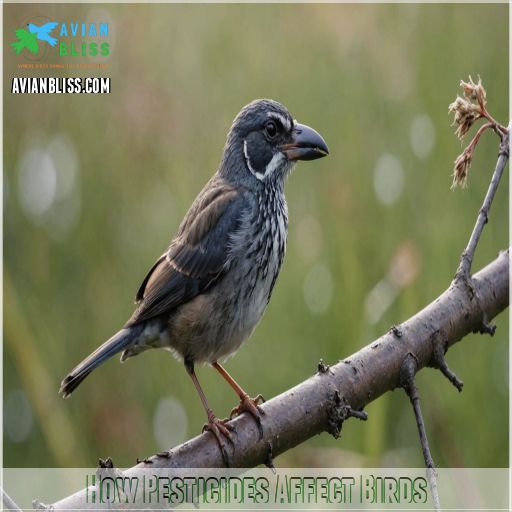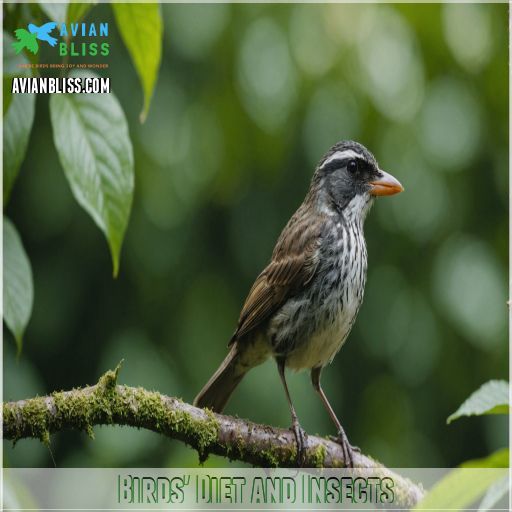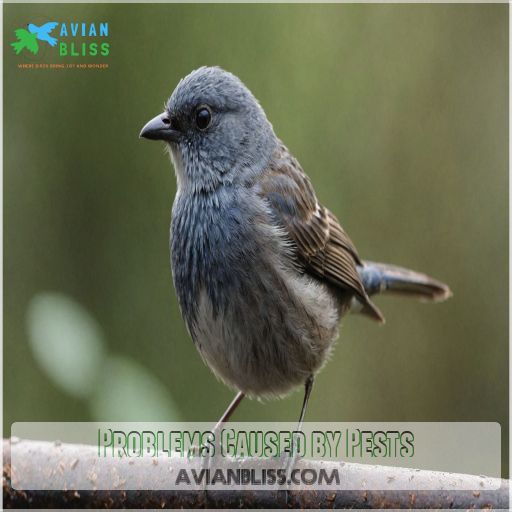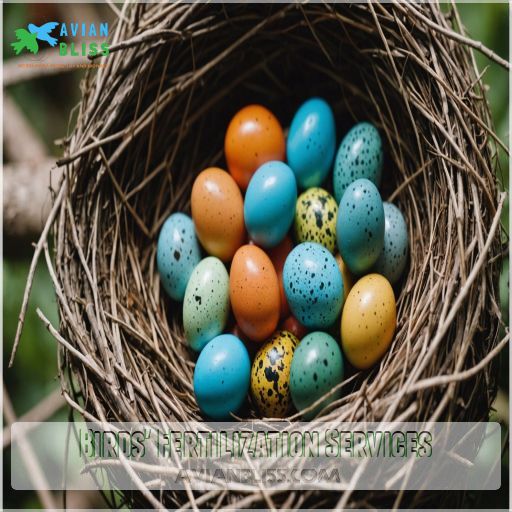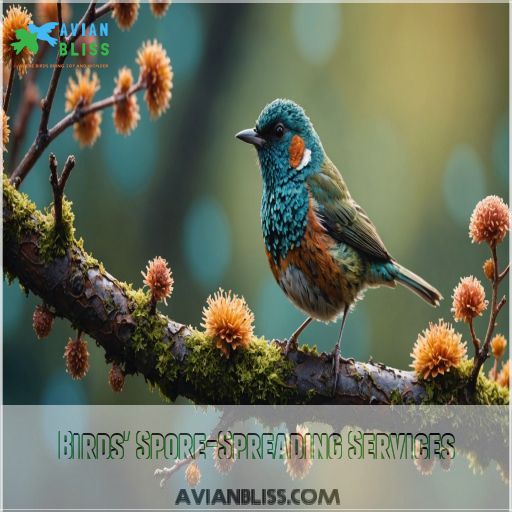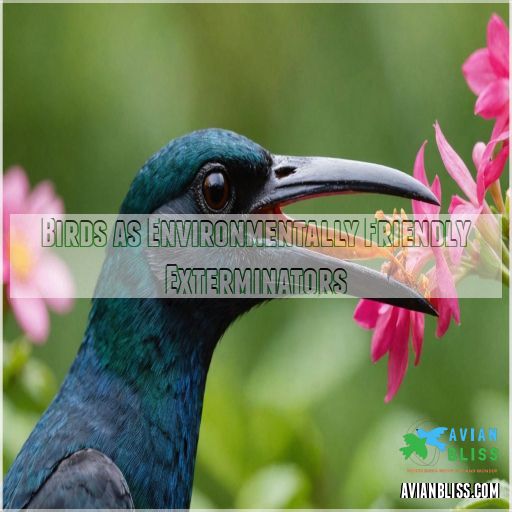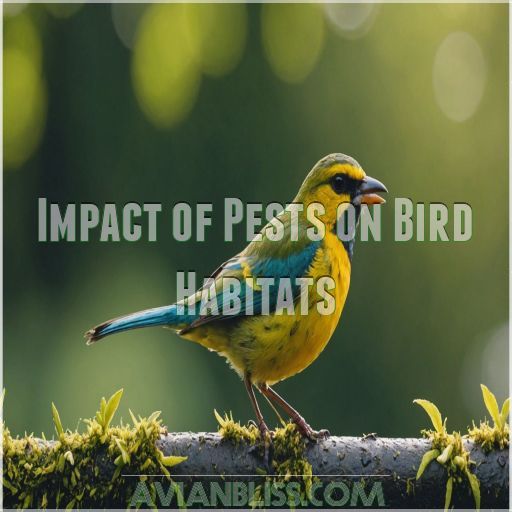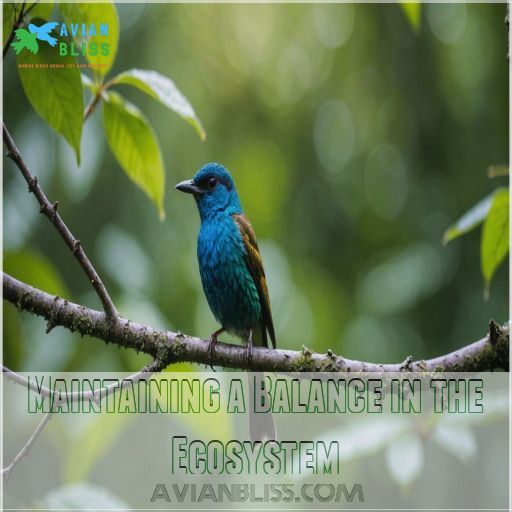This site is supported by our readers. We may earn a commission, at no cost to you, if you purchase through links.
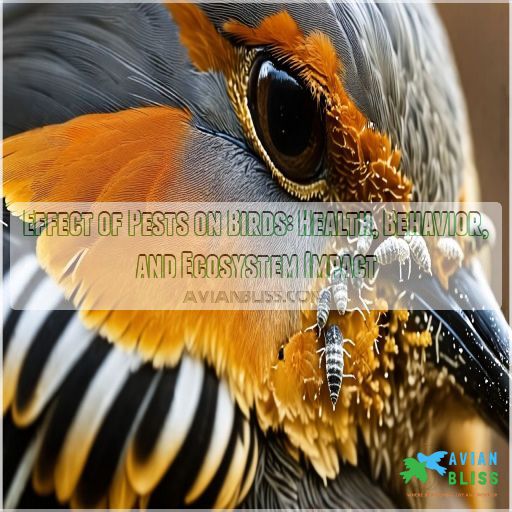 Pests can really ruffle a bird’s feathers! They play havoc with bird health, spreading diseases like West Nile virus and avian jungle fever. Mosquitoes and ticks love crashing their nests, causing illness and even chick loss. Imagine trying to enjoy dinner with fleas and mites making you itch! Pests also stress birds out, prompting erratic behavior and sometimes nest abandonment—talk about moving houses!
Pests can really ruffle a bird’s feathers! They play havoc with bird health, spreading diseases like West Nile virus and avian jungle fever. Mosquitoes and ticks love crashing their nests, causing illness and even chick loss. Imagine trying to enjoy dinner with fleas and mites making you itch! Pests also stress birds out, prompting erratic behavior and sometimes nest abandonment—talk about moving houses!
On the flip side, birds are nature’s pest control, munching many insects. This pest-bird dance affects both health and behavior, and you’ll want to hear how it shapes ecosystems.
Curious about how this ends? Stay tuned!
Table Of Contents
- Key Takeaways
- Birds and Pests Relationship
- Birds’ Role in Pest Control
- How Pesticides Affect Birds
- Birds’ Diet and Insects
- Problems Caused by Pests
- Birds’ Fertilization Services
- Birds’ Spore-Spreading Services
- Birds as Environmentally Friendly Exterminators
- Impact of Pests on Bird Habitats
- Maintaining a Balance in The Ecosystem
- Frequently Asked Questions (FAQs)
- Does pest control affect birds?
- How can pesticides affect birds?
- Do birds need insects to survive?
- What problems do pests cause?
- How do pests affect bird migration patterns?
- What adaptations help birds resist pest infestations?
- Can pest abundance influence bird breeding success?
- How do pests impact bird population dynamics?
- Are certain bird species more vulnerable to pests?
- Conclusion
Key Takeaways
- You’ll find pests like mosquitoes and ticks spread diseases to birds, affecting their health and causing stress that might lead to nest abandonment.
- Birds naturally eat a variety of insects, such as caterpillars and beetles, which provide vital amounts of proteins and fats, by eating insects, reducing your need for chemical pesticides and supporting healthier ecosystems.
- Pesticides can harm birds directly by poisoning them and indirectly by reducing their food sources, impacting their survival.
- Insects are crucial to a bird’s diet, especially during breeding season, providing essential nutrients that help young birds thrive, and birds like warblers and flycatchers are skilled at catching butterflies in mid-air, providing essential nutrients that help young birds thrive.
Birds and Pests Relationship
You might think pests only inconvenience birds, but they can affect health and behavior dramatically, just like how a tiny fly in your room can change your whole evening’s mood.
From blood-sucking mites to feather-chewing lice, these pests are the pesky roommates birds never wanted, impacting their health, nesting, and survival strategies.
Types of Pests Affecting Birds
Understanding pests affecting birds is like peeling an onion—layers of impact!
Four common troublemakers are:
- Mosquitoes: They spread West Nile virus, a bird’s worst nightmare.
- Ticks: Culprits behind avian jungle fever.
- Fleas: Tiny jumpers causing distress in bird communities.
- Mites and Lice: They bring bird scabies, irritating our feathery friends’ skin.
Impact of Pests on Bird Health
Pests like mosquitoes, ticks, and fleas can carry diseases that harm birds, including avian jungle fever, West Nile virus, and Lyme disease.
Birds infected with these diseases may experience exhaustion, loss of appetite, trouble flying, and even death.
Additionally, mites, lice, and worms can cause avian scabies and anemia. Ants, wasps, and beetles also attack bird nests, causing distress to both adult birds and their young.
How Pests Affect Bird Behavior
Imagine waking up to ants in your breakfast! Birds face pests affecting behavior through:
- Nest Parasitism: Parasitic insects invade nest spaces, leading to chick loss.
- Predator Avoidance: Pests like mosquitoes increase stress, causing erratic, cautious actions.
- Foraging Strategies: House Sparrows exploit human-made habitats for food, such as bird feeders and scraps, adapting their foraging behavior to survive in varying environments. Birds adapt by changing food search patterns, impacting ecosystem services.
Integrated pest management aids balance, engaging all stakeholders.
Birds’ Role in Pest Control
You may not realize it, but birds are your secret weapon against pesky insects.
These feathered friends are natural pest control experts, using their sharp eyes and nimble beaks to gobble up a wide variety of crop-damaging bugs.
Birds’ Natural Pest Suppression Services
Birds are unsung heroes on farms when it comes to natural pest suppression.
Their role in pest control cuts down the need for insecticides, fostering healthier crops and ecosystems.
By managing birds’ habitats and understanding bird-pest interactions through DNA-based methods, you can amplify their pest control effectiveness.
Who knew these chirpy creatures were secret agents of your farm’s success?
| Aspect | Benefit |
|---|---|
| Pest Control Effectiveness | Reduces insecticide use |
| Crop Diversification | Supports various plant species |
| Bird Habitat Management | Enhances bird presence |
| Landscape Complexity | Increases ecological balance |
| DNA-Based Methods | Advances molecular diet analysis |
Types of Birds Involved in Pest Control
In insect control, you’ll find many birds lending a wing.
These include:
- Insectivorous birds like warblers that munch on bugs.
- Predatory birds such as hawks targeting rodents.
- Diverse bird species choosing habitats with plenty of prey.
- Usage of pest control methods by birds becoming notable allies, though sometimes they may seem drama queens when no pest appears, as they often prioritize protecting their nesting spots from potential threats, like those discussed in ways to deter birds, though sometimes they may seem drama queens when no pest appears.
Effectiveness of Birds in Controlling Pests
Birds’ natural talent for controlling pests is a win-win for you and nature.
Picture Purple Martins munching on mosquitoes, reducing the need for chemical sprays.
They truly are nature’s perfect pest control team!
By supporting diverse bird habitats, you enhance pest control success while boosting biodiversity.
Who knew feathery friends could handle pests with such finesse?
How Pesticides Affect Birds
You might think pesticides only target pests, but they can also harm birds in surprising ways, from affecting their food supply to causing direct harm.
Like an unintended ripple in a pond, these chemicals can reduce bird populations and impact the entire ecosystem.
Direct and Indirect Effects of Pesticides on Birds
Imagine birds feasting on insects, blissfully unaware of pesticide exposure. The effects are a real doozy, both direct and indirect.
You’ve got:
- Ingested toxins causing harm
- Eggs with thin shells
- Lost food sources leading to hunger
- Habitat loss from pesticide drift
Neonicotinoid effects? They pack a punch, disrupting the entire food chain.
Impact of Pesticides on Bird Populations
Consider curiosity as you explore how pesticides like neonicotinoids impact birds.
These chemicals cause pesticide bioaccumulation, resulting in higher bird mortality rates and habitat loss.
It’s like watching a domino effect; as birds’ food sources dwindle, so does their survival.
Imagine if your favorite cafe closed—how would that disrupt your daily routine?
Types of Pesticides Affecting Birds
Many pesticides, like neonicotinoids, organophosphates, and carbamates, can be deadly for birds.
These chemicals may cause direct poisoning when birds ingest contaminated prey or seeds, or indirectly impact their food sources and habitats. (Source)
Fortunately, some pesticides like synthetic pyrethroids are less toxic to birds, though they still require careful use.
Birds’ Diet and Insects
You’ll find that insects are like the fast-food burgers of a bird’s diet—quick, nutritious, and sometimes surprising with their variety.
Unfortunately, the decline in insect populations can leave birds wondering where their next meal’s coming from, impacting their survival and ecosystem roles.
Importance of Insects in a Bird’s Diet
Insects, essential in a bird’s diet, offer high-quality protein key for bird growth and health.
They fuel birds with energy, supporting long migrations and strong immune systems.
With insect decline , birds face challenges in accessing diverse food sources, impacting their adaptations and the broader food web.
It’s a bird-eat-insect world, after all!
Types of Insects Consumed by Birds
A bird’s dining choices include a variety of insects that keep ecosystems buzzing with life.
From beetles and caterpillars to ants and grasshoppers, their palates are as diverse as a buffet spread.
Imagine them feasting:
- Bright orioles munching caterpillars
- Warblers snacking on aphids
- Bluebirds relishing moths
- Sparrows grabbing crickets
Nature’s dinner party, anyone?
Impact of Insect Decline on Bird Populations
Often, when insects disappear, birds face unexpected struggles.
You see, birds rely heavily on insects as a food source, especially during breeding season.
Research shows that some birds, such as insectivorous birds, consume large amounts of pests, reducing crop damage Pest Control by Birds.
A decline in insects leads to food scarcity, directly impacting birds’ ability to thrive and reproduce.
This situation creates an unsettling imbalance in their habitats, stirring up more than a few squawks of concern from scientists.
Problems Caused by Pests
When pests crash the bird party, they wreak havoc on the environment but also on agriculture and human health.
You might think of pests as tiny nuisances, but their impact stretches from crop damage to spreading diseases, making them a formidable foe in our ecosystems.
Economic Impact of Pests on Agriculture
When pests affect a bird’s diet, agriculture feels the sting too. You have to factor in the hefty pest control costs, bird damage claims, and crop loss estimates, like the financial impact of scaly face and leg mite infections that can lead to [reduced egg production rates](https://avianbliss.com/scaly-face-or-leg-mite-infection-in-birds/ due to weight loss and reduced egg production in birds.
Here’s a quick guide:
- Pest control costs escalate with invasive species management.
- Bird damage claims add to economic woes.
- Crop loss estimates highlight immediate financial impacts.
Environmental Impact of Pests
Pests can wreak havoc on the environment, causing habitat loss and disrupting ecosystems.
Invasive species, for instance, often outcompete native plants and animals, leading to a decline in biodiversity.
Agricultural pests also threaten food production, further straining natural resources.
Maintaining a balanced ecosystem is essential to mitigate these environmental impacts.
Human Health Impacts of Pests
Now, let’s chat about the human health impacts of pests.
Pests like mites and birds can transmit pest-borne and zoonotic diseases, posing significant public health risks.
They’re the uninvited guests you’d rather avoid at your dinner party.
To manage these issues, focus on vector control and food safety concerns to make sure everyone’s safe and sound.
Birds’ Fertilization Services
You mightn’t think of bird droppings as a gardener’s treasure, but they’re packed with nutrients that help fertilize the soil.
By scattering their waste, birds contribute to plant growth, making ecosystems flourish and even giving your garden a boost, without the need for a shopping trip to the fertilizer store.
Importance of Bird Droppings as Fertilizers
Birds’ unique physiological adaptations, including their rapid and specialized digestive system, play a key role in maintaining their overall health. Imagine bird guano as nature’s secret recipe for soil health.
Its nutrient composition, rich in nitrogen and phosphorus, offers gourmet treatment for plants.
By maintaining a healthy parrot diet, as seen in normal green or brown droppings, you guarantee top-notch fertilizer quality.
Historically, it boosted agriculture, causing a global boom and even spurring a war over its trade.
By using bird droppings, you contribute to sustainable agriculture, nurturing ecosystems and reducing chemical fertilizers’ ecological impact.
Types of Plants Benefiting From Bird Fertilizers
Bird droppings work wonders as fertilizer, especially for fruit trees in orchards and vineyards.
These natural fertilizers enrich forests and croplands with key nutrients.
Picture a bustling vineyard where grapes thrive thanks to these droppings.
Birds, unknowingly, help maintain lush greenery.
It’s like Mother Nature’s way of recycling, giving plants an extra boost without synthetic additives (Source).
Impact of Bird Fertilizers on Ecosystems
With a touch of whimsy, picture bird droppings as nature’s own garden gnomes, secretly enhancing soil fertility.
These droppings boost nutrient cycling, leading to vigorous plant growth and promoting ecosystem health.
Seabirds transport nutrients from ocean to land, making habitats lush and lively.
If you care about a thriving ecosystem, thank birds for their droppings’ contributions.
Birds’ Spore-Spreading Services
You may not realize it, but birds play a vital role in dispersing spores throughout forest ecosystems.
These feathered friends act as natural couriers, transporting spores from one plant to another and helping diverse fungi and plants thrive.
Importance of Birds in Spore Dispersal
Just as birds enhance plant growth with their droppings, they also boost forest health by spreading spores.
They consume fungi, including truffles, and excrete viable spores, promoting seed viability and increasing plant diversity.
This natural partnership enhances ecosystems, demonstrating how these feathered friends are the unsung heroes of spore dispersal and nature’s gardeners.
Types of Plants Benefiting From Bird Spore-Spreading
It’s fascinating how birds assist different plants through spore-spreading!
You’d be amazed at the variety: fruiting trees, orchids, ferns, conifers, and even mosses benefit from this natural service.
Their beaks and feathers act as perfect carriers, promoting growth far and wide.
It’s like a magical gardening troupe without the garden gloves or watering cans!
Impact of Bird Spore-Spreading on Forest Ecosystems
Explore the impact of birds’ spore-spreading on forest ecosystems.
As birds feast on fungi like truffles, they unintentionally disperse spores, which support underground fungal networks essential for tree health.
This process enhances forest health by promoting fungal diversity, reinforcing ecosystem resilience despite challenges.
So imagine birds unknowingly playing forest healthcare providers while going about their daily food hunt!
Birds as Environmentally Friendly Exterminators
Imagine having free pest control without harmful chemicals—birds are your allies, swooping in with natural efficiency.
You’ll find their services both practical and entertaining, as these feathered exterminators munch bugs while adding a bit of winged flair to your garden’s ecosystem.
Advantages of Using Birds in Pest Control
While birds soar high spreading spores, they also excel as natural exterminators, safeguarding crops through integrated pest management.
For instance, bird species like Evening Grosbeaks tackle pesky insects efficiently, reducing the need for pesticides.
Embrace bird-friendly farming to harness these winged warriors, reducing pesticide reliance.
Their appetite for pests encourages biodiversity and habitat conservation, balancing ecosystems and keeping your garden pest-free.
You might say nature’s little gardeners know their jobs well!
Challenges of Using Birds in Pest Control
Considering the benefits of birds in pest control, you face challenges too.
These challenges include:
- Crop Damage: Birds might munch on your crops, leaving you more worried than a scarecrow.
- Diseases: Birds can spread diseases, affecting other wildlife or even humans.
- Inconsistent Predator Control: Birds aren’t always dependable; they sometimes skip meals or switch habitats.
Impact of Pests on Bird Habitats
Pests can wreak havoc on bird habitats, disrupting their nesting and breeding activities.
Effective pest management strategies are essential to maintain healthy bird populations and preserve the delicate balance of ecosystems.
Types of Pests Affecting Bird Habitats
You might think bird habitats are pest-free zones, but mosquitoes, ticks, mites, fleas, and parasites are uninvited guests .
They aren’t just pesky; they spread diseases and stress, weakening birds.
Picture mosquitoes at a barbecue—unwelcome, annoying, yet persistent!
Here’s a quick view on these nuisances:
| Pest | Effect on Birds | Control Method |
|---|---|---|
| Mosquitoes | Disease spread | Habitat cleaning |
| Ticks | Blood loss | Proper grooming |
| Mites | Skin irritation | Dust bathing |
| Fleas | Anemia | Regular checks |
| Parasites | Health decline | Medication use |
Impact of Pests on Bird Nesting and Breeding
Imagine pesky pests disrupting bird nesting and breeding.
These nuisances can lead to pest-induced nest abandonment and parasite transmission.
Here’s how pests may affect nesting:
- Nest Material Quality – Pests degrade materials, weakening nests.
- Predator Attraction – Pests draw predators to nests, risking eggs and chicks.
- Breeding Success Impact – Reduced reproductive success due to stress.
Strategies for Managing Pests in Bird Habitats
While pests can impact bird nesting, you can manage them with smart strategies.
Place nest boxes to avoid predators, restore habitats, and reduce pesticide use.
Employ integrated pest management for a science-based approach that minimizes harm.
Here’s a basic strategy outline:
| Technique | Purpose | Benefit |
|---|---|---|
| Nest Box Placement | Protect nests from predators | Increased nesting |
| Habitat Restoration | Improve natural environments | Enhanced biodiversity |
| Pesticide Reduction | Decrease pesticide exposure | Safer for birds |
Maintaining a Balance in The Ecosystem
When pests and birds coexist peacefully, the ecosystem flourishes like a perfectly balanced seesaw.
By managing both pest and bird populations effectively, you can preserve this harmony and enjoy an environment bustling with life while avoiding a Hitchcock-style bird invasion.
Importance of Maintaining a Balance in The Ecosystem
Pests gnawing at bird habitats remind us that ecosystems thrive on balance.
By promoting biodiversity, we support natural cycles where each species, including birds, plays a part in the grand dance of life.
Imagine an orchestra missing its instruments; that’s us without a balanced ecosystem.
Conservation efforts protect species from invasive newcomers, stabilizing our shared environment for future generations.
Strategies for Managing Pests and Birds
Balancing the ecosystem involves smart strategies.
Consider these:
- Bird-friendly farming: Encourage birds to manage pests naturally.
- Integrated pest management: Use biological controls for sustainable pest reduction.
- Habitat conservation: Preserve natural habitats; they maintain predator-prey balance.
With these in mind, you’re not just fighting pests, but also nurturing a harmonious, enjoyable ecosystem.
Impact of Maintaining a Balance on The Environment
How can you maintain a balance in the ecosystem and benefit the environment?
By preserving biodiversity, you support sustainable agriculture and effective pest control, which even small bird with a loud song species, like the ones found at Carolina Wren’s loud melodies, rely on.
This safeguards ecosystem services like bird conservation, ensuring nature’s delicate balance remains intact.
It’s a win-win – your backyard will thrive, and the planet will too!
Frequently Asked Questions (FAQs)
Does pest control affect birds?
Did you know a single pesticide-coated seed can kill a songbird?
Pest control affects birds by poisoning them, thinning eggshells, and reducing food sources.
Even your kitchen bug spray could harm these feathered friends.
How can pesticides affect birds?
Pesticides can reduce bird populations by contaminating their food and habitat.
Birds ingest these pesticides through treated seeds or prey and suffer effects like eggshell thinning, reduced reproduction rates, or even acute poisoning.
Do birds need insects to survive?
Birds definitely need insects for survival, especially during breeding season.
Insects provide essential nutrients, particularly for nestlings.
Without these slimy snacks, many young birds would struggle to thrive, proving bugs are more help than hindrance.
What problems do pests cause?
Imagine a world overrun by pests!
They cause chaos by damaging buildings, blocking ventilation systems, and spreading over 60 diseases.
Pest droppings can ruin roofs and machinery, leading to astronomical repair bills and health risks (Source).
How do pests affect bird migration patterns?
Pests can disrupt bird migration by reducing food sources, altering habitats, and causing birds to change their flight paths.
Storms, temperature shifts, and wind patterns also impact when and where birds travel.
What adaptations help birds resist pest infestations?
To resist pest infestations, birds adapt with behaviors like selecting pest-resistant habitats and using plants that produce natural pest repellents.
Birds also control pests naturally through their diets, which include pest insects.
It’s a win-win!
Can pest abundance influence bird breeding success?
Ever wonder if pests impact bird breeding success?
In fact, abundant insect pests can boost bird reproduction by enhancing food availability, especially for insectivores needing protein-rich diets for their chicks.
However, disturbance to the nest can significantly impact these chances, as it can cause parents to abandon their young, learn about nest abandonment causes. This, in turn, improves hatchling growth and nest survival.
How do pests impact bird population dynamics?
Bird populations fluctuate with pest availability since many birds rely on insects for food.
Declines in pest populations, often due to habitat changes or pesticide use, directly reduce food sources, impacting bird breeding success and population stability.
Are certain bird species more vulnerable to pests?
Some bird species, like hummingbirds, can be more vulnerable to pests due to their specific diets or nesting habitats.
Integrated Pest Management (IPM) helps protect these birds by balancing pest control with environmental stewardship.
Conclusion
Imagine this: birds and pests are like a cosmic dance from Saturday Night Fever, shaping the environment dramatically.
Pests impact bird health and behavior, influencing their role as natural exterminators.
While protecting crops, birds maintain important ecosystem balances.
However, pests also affect nesting and habitats.
Understanding the effect of pests on birds helps us appreciate their important role in pest control and ecosystem health.
Embracing this dynamic can lead to healthier environments and stronger biodiversity.



